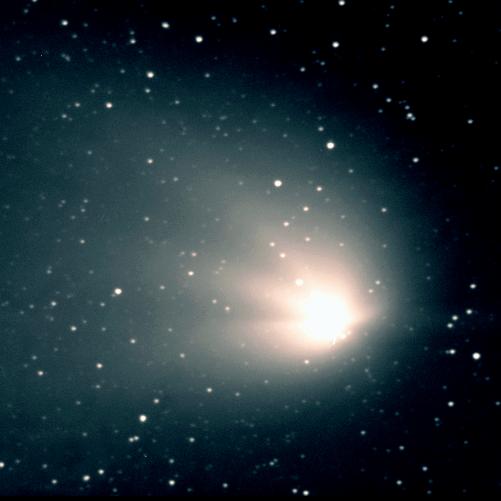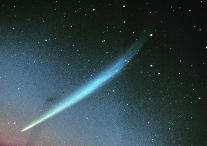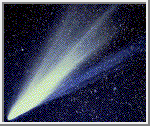Comets
 Unlike the other small bodies in the solar system, comets have been known
since antiquity. There are Chinese records of Comet Halley going back to at least
240 BC. The famous Bayeux Tapestry, which commemorates the Norman
Conquest of England in 1066, depicts an apparition of Comet Halley.
Unlike the other small bodies in the solar system, comets have been known
since antiquity. There are Chinese records of Comet Halley going back to at least
240 BC. The famous Bayeux Tapestry, which commemorates the Norman
Conquest of England in 1066, depicts an apparition of Comet Halley.
Comets are small, fragile, irregularly shaped bodies composed of a mixture of non-volatile grains and frozen gases. They have highly elliptical orbits that bring them very close to the Sun and swing them deeply into space, often beyond the orbit of Pluto.
 Comet structures are diverse and very dynamic, but they all develop a
surrounding cloud of diffuse material, called a coma, that usually grows in
size and brightness as the comet approaches the Sun. Usually a small,
bright nucleus (less than 10 km in diameter) is visible in the middle of the
coma. The coma and the nucleus together constitute the head of the comet.
Comet structures are diverse and very dynamic, but they all develop a
surrounding cloud of diffuse material, called a coma, that usually grows in
size and brightness as the comet approaches the Sun. Usually a small,
bright nucleus (less than 10 km in diameter) is visible in the middle of the
coma. The coma and the nucleus together constitute the head of the comet.
As comets approach the Sun they develop enormous tails of luminous material that extend for millions of kilometers from the head, away from the Sun. When far from the Sun, the nucleus is very cold and its material is frozen solid within the nucleus. In this state comets are sometimes referred to as a "dirty iceberg" or "dirty snowball," since over half of their material is ice. When a comet approaches within a few AU of the Sun, the surface of the nucleus begins to warm, and volatiles evaporate. The evaporated molecules boil off and carry small solid particles with them, forming the comet's coma of gas and dust.
The Sun's radiation pressure and solar wind accelerate materials away from the comet's head at differing velocities according to the size and mass of the materials. Thus, relatively massive dust tails are accelerated slowly and tend to be curved. The ion tail is much less massive, and is accelerated so greatly that it appears as a nearly straight line extending away from the comet opposite the Sun. The picture of Comet West (above right) shows two distinct tails. The thin blue plasma tail is made up of gases and the broad white tail is made up of microscopic dust particles.
 Tracking a Comet
Tracking a Comet
Because the tail is always pointed away
from the sun, many times a comet will appear to move sideways in
relation to the direction of its tail (as in
the animation shown on the left). When a comet is moving away from
the sun, it will move in the direction of its gas and dust tail, and
thus appearing to move backwards!

